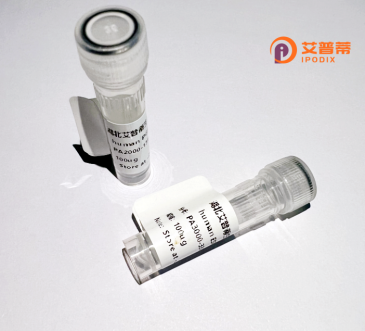
| 纯度 | >90%SDS-PAGE. |
| 种属 | Human |
| 靶点 | RASGRP2 |
| Uniprot No | Q7LDG7 |
| 内毒素 | < 0.01EU/μg |
| 表达宿主 | E.coli |
| 表达区间 | 1-609 aa |
| 活性数据 | MAGTLDLDKG CTVEELLRGC IEAFDDSGKV RDPQLVRMFL MMHPWYIPSS QLAAKLLHIY QQSRKDNSNS LQVKTCHLVR YWISAFPAEF DLNPELAEQI KELKALLDQE GNRRHSSLID IDSVPTYKWK RQVTQRNPVG QKKRKMSLLF DHLEPMELAE HLTYLEYRSF CKILFQDYHS FVTHGCTVDN PVLERFISLF NSVSQWVQLM ILSKPTAPQR ALVITHFVHV AEKLLQLQNF NTLMAVVGGL SHSSISRLKE THSHVSPETI KLWEGLTELV TATGNYGNYR RRLAACVGFR FPILGVHLKD LVALQLALPD WLDPARTRLN GAKMKQLFSI LEELAMVTSL RPPVQANPDL LSLLTVSLDQ YQTEDELYQL SLQREPRSKS SPTSPTSCTP PPRPPVLEEW TSAAKPKLDQ ALVVEHIEKM VESVFRNFDV DGDGHISQEE FQIIRGNFPY LSAFGDLDQN QDGCISREEM VSYFLRSSSV LGGRMGFVHN FQESNSLRPV ACRHCKALIL GIYKQGLKCR ACGVNCHKQC KDRLSVECRR RAQSVSLEGS APSPSPMHSH HHRAFSFSLP RPGRRGSRPP EIREEEVQTV EDGVFDIHL |
| 分子量 | 69.2 kDa |
| 蛋白标签 | His tag N-Terminus |
| 缓冲液 | PBS, pH7.4, containing 0.01% SKL, 1mM DTT, 5% Trehalose and Proclin300. |
| 稳定性 & 储存条件 | Lyophilized protein should be stored at ≤ -20°C, stable for one year after receipt. Reconstituted protein solution can be stored at 2-8°C for 2-7 days. Aliquots of reconstituted samples are stable at ≤ -20°C for 3 months. |
| 复溶 | Always centrifuge tubes before opening.Do not mix by vortex or pipetting. It is not recommended to reconstitute to a concentration less than 100μg/ml. Dissolve the lyophilized protein in distilled water. Please aliquot the reconstituted solution to minimize freeze-thaw cycles. |
以下是关于重组人RASGRP2蛋白的3篇参考文献示例:
---
1. **文献名称**: "RASGRP2 regulates platelet activation and promotes thrombosis in mice"
**作者**: Berrou, E. et al.
**摘要**: 本研究揭示了RASGRP2(CalDAG-GEFI)在血小板活化中的关键作用。通过构建RASGRP2基因敲除小鼠,发现其血小板RAP1激活受损,导致血栓形成减少,表明该蛋白可作为抗血栓治疗的新靶点。
---
2. **文献名称**: "A novel RASGRP2 mutation causes platelet dysfunction and severe bleeding"
**作者**: Canault, M. et al.
**摘要**: 报道了一种新型RASGRP2突变导致患者血小板功能障碍和严重出血的临床病例。研究发现,突变显著降低了RASGRP2对RAP1的激活能力,提示重组RASGRP2蛋白可能用于基因治疗。
---
3. **文献名称**: "Structural basis of RASGRP2 recognition by small molecules in bleeding disorders"
**作者**: Stefanini, L. et al.
**摘要**: 通过X射线晶体学解析了重组人RASGRP2蛋白的结构,鉴定了其与RAP1结合的活性位点,并筛选出能增强RASGRP2功能的小分子化合物,为治疗相关出血性疾病提供新策略。
---
如需更多文献,可补充查阅近年关于RASGRP2在免疫或血栓领域的研究。
RASGRP2 (RAS Guanyl Releasing Protein 2) is a member of the RASGRP family of guanine nucleotide exchange factors (GEFs) that regulate RAS-like small GTPases, particularly RAP1. Primarily expressed in hematopoietic cells, including platelets, T cells, and neutrophils, it plays a pivotal role in intracellular signaling pathways governing cell adhesion, migration, and activation. Structurally, RASGRP2 contains a catalytic RASGEF domain, a calcium-sensitive EF-hand motif, and a diacylglycerol (DAG)-binding C1 domain, enabling its regulation by second messengers like calcium and DAG.
In platelets, RASGRP2 activates RAP1 to promote integrin αIIbβ3 activation, a critical step in thrombus formation. Mutations or deficiencies in RASGRP2 are linked to bleeding disorders such as platelet-type von Willebrand disease, characterized by impaired platelet aggregation. Beyond hemostasis, it influences immune cell functions; in T cells, RASGRP2 modulates integrin-mediated adhesion and immune synapse formation. Dysregulation of RASGRP2 has been implicated in pathological conditions, including leukemia and autoimmune diseases, highlighting its dual roles in health and disease.
Recombinant RASGRP2 protein is widely used to study its biochemical properties, signaling mechanisms, and interactions with GTPases. Its therapeutic potential is being explored for modulating platelet activity or immune responses in thrombosis and inflammation-related disorders. Ongoing research aims to elucidate cell-specific regulatory networks and develop targeted interventions leveraging RASGRP2’s unique signaling nodes.
×